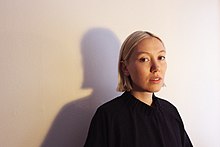Ellen Arkbro: Difference between revisions
→External links: carillon |
m Arkbro in 2016 |
||
| Line 5: | Line 5: | ||
|birth_place=[[Stockholm|Stockholm, Sweden]] |
|birth_place=[[Stockholm|Stockholm, Sweden]] |
||
|image = EllenArkbro.jpg |
|image = EllenArkbro.jpg |
||
|caption = |
|caption = Arkbro in 2016 |
||
|alma_mater=[[:sv:Elektronmusikstudion|Elektronmusikstudion]];<br>[[Royal College of Music, Stockholm]] |
|alma_mater=[[:sv:Elektronmusikstudion|Elektronmusikstudion]];<br>[[Royal College of Music, Stockholm]] |
||
|known_for= |
|known_for= |
||
Revision as of 20:58, 23 October 2022
Ellen Arkbro | |
|---|---|
 Arkbro in 2016 | |
| Born | 1990 |
| Alma mater | Elektronmusikstudion; Royal College of Music, Stockholm |
| Known for | |
| Musical career | |
| Instruments | |
| Website | ellenarkbro.com |
Ellen Arkbro (born 1990) is a Swedish avant-garde composer working largely in meantone temperament.[2] Her primary instrument is the pipe organ, and she also composes for brass and winds. Early work makes ample use of the text-based programming environment SuperCollider as a tonality design resource[3] in which "there are some very natural ways of working with rational frequency relationships."[4]
Early life
Arkbro was born in Stockholm. Excelling in church choir she resolved to study jazz, only to find that jazz depressingly compelled her to seek an opposite aesthetic direction.[5] After attending Elektronmusikstudion in Stockholm, and upon completing a degree in electroacoustic composition at the Royal College of Music in Stockholm, Arkbro studied just intonation under the tutelage of LaMonte Young, Marian Zazeela and Jung Hee Choi in New York[6] and Marc Sabat in Berlin.[3]
Recordings
For Organ and Brass
For her 2017 debut album For Organ and Brass, Arkbro, who was raised Baptist,[7] uses the Sherer-Orgel organ at St. Stephen's Church in Tangermünde, Germany, an instrument dating to 1624,[8] in a church dating to 1118.[9] The LP comprises recordings of her compositions in just intonation for renaissance organ, horn, trombone and microtonal tuba.[2]
The [title] piece came about while I was spending time with the meantone temperament of the organ in the German Church in Stockholm. I soon came to realise that I could use this traditional renaissance tuning in a non-traditional way that would allow me to compose music solely with septimal intervals. These are sounds that I have to come to love for their unique character. There is a textural aspect of these intervals which makes them stand out from the rest. And then there is the equally important affective aspect: a kind of open, clear sadness [which are] some of the reasons to why I’ve ended up working with them.[6]
CHORDS
CHORDS (2019) was designed to draw attention to the way sound exists in space, the way tonality and harmony affect an environment. The music is intended for large speakers, allowing it to take over a home and envelop the listener.[10]
Pitchfork finds that the album "delves even deeper into microtonal interplay, balancing heady theoretical terrain with a rare emotional resonance. [Arkbro's] music is infused with a profound emotionality that transcends its heady origins. Passing through the gates of extreme rigor, CHORDS finds private infinity in a handful or stretched-out drones."[11]
Sounds while waiting
Sounds while waiting (2021) is an album that explores the long drawn out manner of playing chords in a resonant space. It focuses on exploring the depths of a "rough, focused and yet strangely transparent" form of "texturality". The instrumentation consists of organ and cymbals and the album contains the two-parter "Sculpture", along with 2 others.
Concerts
During the coronavirus pandemic in 2021, Arkbro performed at the medieval Church of São Martinho de Cedofeita, in the municipality of Porto, Portugal.[12]
Discography
Hästköttskandalen
- 2015: Spacegirls (Fylkingen Records)
Solo
- 2017: For Organ and Brass (Subtext Recordings)
- 2019: CHORDS (Subtext Recordings)
References
- ^ Hroch, M., "Kam Nás Zvuk Zavede: Varhanní experimenty Ellen Arkbro a Kali Malone", A2, #20, 2019.
- ^ a b Anon., Resident Advisor, Ellen Arkbro.
- ^ a b Heller, R., "The In-Tune-Sound From Way Out: Ellen Arkbro Interviewed", The Quietus, July 24, 2019.
- ^ McVicar, G., "486 Hertz—Ellen Arkbro", Stray Landings, December 12, 2017.
- ^ Costa, F., "Ellen Arkbro: 'Penso que algo acontece com a tua escuta quando estás numa igreja porque existe uma certa consciência'", Rimas e Batidas (in Portuguese), April 23, 2021.
- ^ a b Sawers, C., "Listen to Ellen Arkbro's forthcoming release on Subtext", The Wire, April 2017.
- ^ Skates, A., "Deep Time: The Shifting Force Fields Of Ellen Arkbro's CHORDS", The Quietus, July 4, 2019.
- ^ Bruce-Jones, H., "Composer Ellen Arkbro returns to Subtext with CHORDS", Fact, May 23, 2019.
- ^ Anon., "Dreaming and letting go | A conversation with Ellen Arkbro", RE:VIVE, April 21, 2017.
- ^ Joyce, C., "Ellen Arkbro’s Noisey Mix Is Mystifying Music for Deep Listening", Vice, July 16, 2019.
- ^ Martin-McCormick, D., "Ellen Arkbro—CHORDS", Pitchfork, June 18, 2019.
- ^ Vieira, A. B., "Ellen Arkbro vai transformar o órgão de tubos da igreja de Cedofeita num sintetizador", Público, April 28, 2021.
External links
- Official website
- Ellen Arkbro on Bandcamp
- Ellen Arkbro on SoundCloud
- Ellen Arkbro on NTS Radio
- Ellen Arkbro on Twitter
- Hör ny musik av Ellen Arkbro, Sveriges Radio, January 22, 2020.
